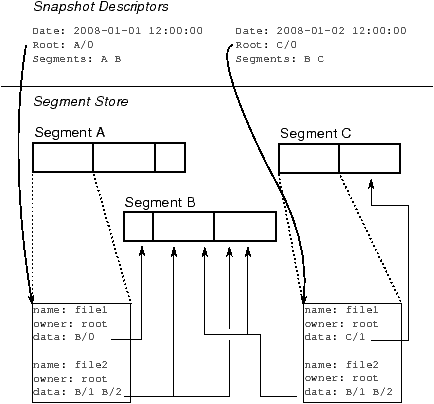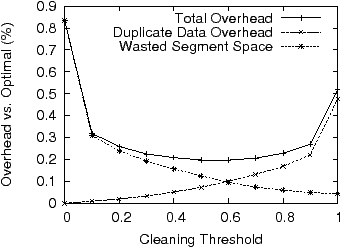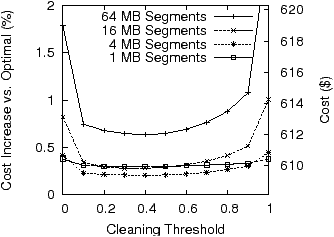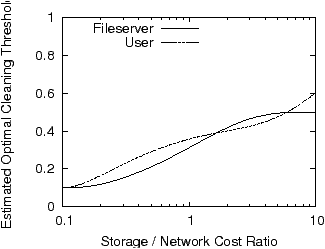
Cumulus: Filesystem Backup to the Cloud
Michael Vrable,
Stefan Savage, and
Geoffrey M. Voelker
Department of Computer Science and Engineering
University of California, San Diego
|
Abstract:
In this paper we describe Cumulus, a system for efficiently implementing
filesystem backups over the Internet. Cumulus is specifically designed
under a thin cloud assumption—that the remote datacenter storing
the backups does not provide any special backup services, but only
provides a least-common-denominator storage interface (i.e., get and put
of complete files). Cumulus aggregates data from small files for remote
storage, and uses LFS-inspired segment cleaning to maintain storage
efficiency. Cumulus also efficiently represents incremental changes,
including edits to large files. While Cumulus can use virtually any
storage service, we show that its efficiency is comparable to integrated
approaches.
1 Introduction
It has become increasingly popular to talk of “cloud computing” as the
next infrastructure for hosting data and deploying software and
services. Not surprisingly, there are a wide range of different
architectures that fall under the umbrella of this vague-sounding term,
ranging from highly integrated and focused (e.g., Software As A Service
offerings such as Salesforce.com) to decomposed and abstract (e.g.,
utility computing such as Amazon’s EC2/S3). Towards the former end of
the spectrum, complex logic is bundled together with abstract resources
at a datacenter to provide a highly specific service—potentially
offering greater performance and efficiency through integration, but
also reducing flexibility and increasing the cost to switch providers.
At the other end of the spectrum, datacenter-based infrastructure
providers offer minimal interfaces to very abstract resources (e.g.,
“store file”), making portability and provider switching easy, but
potentially incurring additional overheads from the lack of server-side
application integration.
In this paper, we explore this thin-cloud vs. thick-cloud
trade-off in the context of a very simple application: filesystem
backup. Backup is a particularly attractive application for outsourcing to
the cloud because it is relatively simple, the growth of disk capacity
relative to tape capacity has created an efficiency and cost
inflection point, and the cloud offers easy off-site storage, always a key
concern for backup. For end users there are few backup solutions
that are both trivial and reliable (especially against disasters such
as fire or flood), and ubiquitous broadband now provides sufficient
bandwidth resources to offload the application. For small to
mid-sized businesses, backup is rarely part of critical business
processes and yet is sufficiently complex to “get right” that it can
consume significant IT resources. Finally, larger enterprises
benefit from backing up to the cloud to provide a business continuity
hedge against site disasters.
However, to price cloud-based backup services attractively requires
minimizing the capital costs of data center storage and the
operational bandwidth costs of shipping the data there and back. To
this end, most existing cloud-based backup services (e.g., Mozy,
Carbonite, Symantec’s Protection Network) implement integrated
solutions that include backup-specific software hosted on both the
client and at the data center (usually using servers owned by the
provider). In principle, this approach allows greater storage and bandwidth
efficiency (server-side compression, cleaning, etc.) but also reduces
portability—locking customers into a particular provider.
In this paper we explore the other end of the design space—the thin
cloud. We describe a cloud-based backup system, called Cumulus, designed
around a minimal interface (put, get, delete, list) that is trivially portable to virtually any on-line storage
service. Thus, we assume that any application logic is
implemented solely by the client. In designing and evaluating this
system we make several contributions. First, we show through
simulation that, through careful design, it is possible to build
efficient network backup on top of a generic storage
service—competitive with integrated backup solutions, in spite of
having no specific backup support in the underlying storage service.
Second, we build a working prototype of this system using Amazon’s
Simple Storage Service (S3) and demonstrate its effectiveness on real
end-user traces. Finally, we describe how such systems can be tuned
for cost instead of for bandwidth or storage, both using the
Amazon pricing model as well as for a range of storage to network cost
ratios.
In the remainder of this paper, we first describe prior work in backup
and network-based backup, followed by a design overview of Cumulus and an
in-depth description of its implementation. We then provide both
simulation and experimental results of Cumulus performance, overhead, and
cost in trace-driven scenarios. We conclude with a discussion of the
implications of our work and how this research agenda might be further
explored.
2 Related Work
Many traditional backup tools are designed to work well for tape
backups. The dump, cpio, and tar [16] utilities are common on
Unix systems and will write a full filesystem backup as a single stream
of data to tape. These utilities may create a full backup of a
filesystem, but also support incremental backups, which only
contain files which have changed since a previous backup (either full or
another incremental). Incremental backups are smaller and faster to
create, but mostly useless without the backups on which they are based.
Organizations may establish backup policies specifying at what
granularity backups are made, and how long they are kept. These
policies might then be implemented in various ways. For tape backups,
long-term backups may be full backups so they stand alone; short-term
daily backups may be incrementals for space efficiency. Tools such as
AMANDA [2] build on dump or tar, automating the process of
scheduling full and incremental backups as well as collecting backups
from a network of computers to write to tape as a group. Cumulus
supports flexible policies for backup retention: an administrator does
not have to select at the start how long to keep backups, but rather can
delete any snapshot at any point.
The falling cost of disk relative to tape makes backup to disk more
attractive, especially since the random access permitted by disks
enables new backup approaches. Many recent backup tools, including
Cumulus, take advantage of this trend. Two approaches for comparing
these systems are by the storage representation on disk, and by the
interface between the client and the storage—while the disk could be
directly attached to the client, often (especially with a desire to
store backups remotely) communication will be over a network.
Rsync [22] efficiently mirrors a filesystem across a network
using a specialized network protocol to identify and transfer only those
parts of files that have changed. Both the client and storage server
must have rsync installed. Users typically want backups at multiple
points in time, so rsnapshot [19] and other wrappers around
rsync exist that will store multiple snapshots, each as a separate
directory on the backup disk. Unmodified files are hard-linked between
the different snapshots, so storage is space-efficient and snapshots are
easy to delete.
The rdiff-backup [7] tool is similar to rsnapshot, but
it changes the storage representation. The most recent snapshot is a
mirror of the files, but the rsync algorithm creates compact deltas
for reconstructing older versions—these reverse incrementals are
more space efficient than full copies of files as in rsnapshot.
Another modification to the storage format at the server is to store
snapshots in a content-addressable storage system.
Venti [17] uses hashes of block contents to address data
blocks, rather than a block number on disk. Identical data between
snapshots (or even within a snapshot) is automatically coalesced into a
single copy on disk—giving the space benefits of incremental backups
automatically. Data Domain [26] offers a similar but more
recent and efficient product; in addition to performance improvements, it uses
content-defined chunk boundaries so de-duplication can be performed even
if data is offset by less than the block size.
A limitation of these tools is that backup data must be stored
unencrypted at the server, so the server must be trusted. Box
Backup [21] modifies the protocol and storage representation
to allow the client to encrypt data before sending, while still
supporting rsync-style efficient network transfers.
Most of the previous tools use a specialized protocol to communicate
between the client and the storage server. An alternate approach is to
target a more generic interface, such as a network file system or an FTP-like
protocol. Amazon S3 [3] offers an HTTP-like interface to storage.
The operations supported are similar enough between these different
protocols—get/put/delete on files and list on directories—that a
client can easily support multiple protocols. Cumulus tries to be
network-friendly like rsync-based tools, while using only a generic
storage interface.
Jungle Disk [13] can perform backups to Amazon S3.
However, the design is quite different from that of Cumulus. Jungle
Disk is first a network filesystem with Amazon S3 as the backing store.
Jungle Disk can also be used for backups, keeping copies of old versions
of files instead of deleting them. But since it is optimized for
random access it is less efficient than Cumulus for pure
backup—features like aggregation in Cumulus can improve compression,
but are at odds with efficient random access.
Duplicity [8] aggregates files together before
storage for better compression and to reduce per-file storage costs at
the server. Incremental backups use space-efficient rsync-style deltas
to represent changes. However, because each incremental backup depends
on the previous, space cannot be reclaimed from old snapshots without
another full backup, with its associated large upload cost. Cumulus was
inspired by duplicity, but avoids this problem of long dependency chains
of snapshots.
Brackup [9] has a design very similar to that of Cumulus.
Both systems separate file data from metadata: each snapshot contains a
separate copy of file metadata as of that snapshot, but file data is
shared where possible. The split data/metadata design allows old
snapshots to be easily deleted. Cumulus differs from Brackup primarily
in that it places a greater emphasis on aggregating small files together
for storage purposes, and adds a segment cleaning mechanism to manage
the inefficiency introduced. Additionally, Cumulus tries to efficiently
represent small changes to all types of large files and can share
metadata where unchanged; both changes reduce the cost of incremental
backups.
Peer-to-peer systems may be used for storing backups.
Pastiche [5] is one such system, and focuses on the problem of
identifying and sharing data between different users. Pastiche uses
content-based addressing for de-duplication. But if sharing is not
needed, Brackup and Cumulus could use peer-to-peer systems as well,
simply treating it as another storage interface offering get and put
operations.
While other interfaces to storage may be
available—Antiquity [24] for example provides a log
append operation—a get/put interface likely still works best since it
is simpler and a single put is cheaper than multiple appends to write
the same data.
| | Multiple snapshots | Simple server | Incremental forever | Sub-file delta storage | Encryption |
| rsync | | | X | N/A | |
| rsnapshot | X | | X | | |
| rdiff-backup | X | | X | X | |
| Box Backup | X | | X | X | X |
| Jungle Disk | X | X | X | | X |
| duplicity | X | X | | X | X |
| Brackup | X | X | X | | X |
| Cumulus | X | X | X | X | X |
Multiple snapshots: Can store multiple versions of files at
different points in time;
Simple server: Can back up almost anywhere; does not require
special software at the server;
Incremental forever: Only initial backup must be a full
backup;
Sub-file delta storage: Efficiently represents small differences
between files on storage; only relevant if storing multiple
snapshots;
Encryption: Data may be encrypted for privacy before sending to
storage server.
| Table 1: Comparison of features among selected tools that back up to
networked storage. |
Table 1 summarizes differences between some
of the tools discussed above for backup to networked storage. In relation
to existing systems, Cumulus is most similar to duplicity (without the need
to occasionally re-upload a new full backup), and Brackup (with an
improved scheme for incremental backups including rsync-style deltas,
and improved reclamation of storage space).
3 Design
In this section we present the design of our approach for making
backups to a thin cloud remote storage service.
3.1 Storage Server Interface
We assume only a very narrow interface between a client generating a
backup and a server responsible for storing the backup.
The interface consists of
four operations:
-
Get:
- Given a pathname, retrieve the contents of a file from the
server.
- Put:
- Store a complete file on the server with the given pathname.
- List:
- Get the names of files stored on the server.
- Delete:
- Remove the given file from the server, reclaiming its
space.
Note that all of these operations operate on entire files; we do not
depend upon the ability to read or write arbitrary byte ranges within a
file. Cumulus neither requires nor uses support for reading and setting
file attributes such as permissions and timestamps. The interface is
simple enough that it can be implemented on top of any number of
protocols: FTP, SFTP, WebDAV, S3, or nearly any network file system.
Since the only way to modify a file in this narrow interface is to
upload it again in full, we adopt a write-once storage model, in
which a file is never modified after it is first stored, except to
delete it to recover space. The write-once model provides convenient
failure guarantees: since files are never modified in place, a failed
backup run cannot corrupt old snapshots. At worst, it will leave a
partially-written snapshot which can garbage-collected. Because Cumulus
does not modify files in place, we can keep snapshots at multiple points
in time simply by not deleting the files that make up old
snapshots.
3.2 Storage Segments
When storing a snapshot, Cumulus will often group data from many smaller
files together into larger units called segments. Segments
become the unit of storage on the server, with each segment stored as a
single file. Filesystems typically contain many small files (both our
traces described later and others, such as [1], support
this observation). Aggregation of data produces larger files for storage at the
server, which can be beneficial to:
Avoid inefficiencies associated with many small files: Storage
servers may dislike storing many small files for various
reasons—higher metadata costs, wasted space from rounding up to block
boundaries, and more seeks when reading. This preference may be
expressed in the cost model of the provider. Amazon S3, for example,
has both a per-request and a per-byte cost when storing a file that
encourages using files greater than 100 KB in size.
Avoid costs in network protocols: Small files result in
relatively larger protocol overhead, and may be slower over
higher-latency connections. Pipelining (if supported) or parallel
connections may help, but larger segments make these less necessary. We
study one instance of this effect in more detail in Section 5.4.5.
Take advantage of inter-file redundancy with segment compression:
Compression can be more effective when small files are grouped together.
We examine this effect in Section 5.4.2.
Provide additional privacy when encryption is used: Aggregation
helps hide the size as well as contents of individual files.
Finally, as discussed in Sections 3.4 and
4.3, changes to small parts of larger files can be
efficiently represented by effectively breaking those files into smaller
pieces during backup. For the reasons listed above, re-aggregating this
data becomes even more important when sub-file incremental backups are
supported.
3.3 Snapshot Format
| Figure 1: Simplified schematic of the basic format for storing
snapshots on a storage server. Two snapshots are shown, taken on
successive days. Each snapshot contains two files. file1
changes between the two snapshots, but the data for file2 is
shared between the snapshots. For simplicity in this figure, segments
are given letters as names instead of the 128-bit UUIDs
used in practice. |
Figure 1 illustrates the basic format for backup
snapshots. Cumulus snapshots logically consist of two parts: a
metadata log which lists all the files backed up, and the file
data itself. Both metadata and data are broken apart into blocks, or
objects, and these objects are then packed together into
segments, compressed as a unit and optionally encrypted, and
stored on the server. Each segment has a unique name—we use a
randomly generated 128-bit UUID so that segment names can be assigned
without central coordination. Objects are numbered sequentially within
a segment.
Segments are internally structured as a TAR file, with each file in the
archive corresponding to an object in the segment. Compression and
encryption are provided by filtering the raw segment data through
gzip, bzip2, gpg, or other similar external
tools.
A snapshot can be decoded by traversing the tree (or, in the case of
sharing, DAG) of objects. The root object in the tree is the start of
the metadata log. The metadata log need not be stored as a flat object;
it may contain pointers to objects containing other pieces of the
metadata log. For example, if many files have not changed, then a
single pointer to a portion of the metadata for an old snapshot may be
written. The metadata objects eventually contain entries for individual
files, with pointers to the file data as the leaves of the tree.
The metadata log entry for each individual file specifies properties
such as modification time, ownership, and file permissions, and can be
extended to include additional information if needed. It includes a
cryptographic hash so that file integrity can be verified after a
restore. Finally, it includes a list of pointers to objects containing
the file data. Metadata is stored in a text, not binary, format to make
it more transparent. Compression applied to the segments containing the
metadata, however, makes the format space-efficient.
The one piece of data in each snapshot not stored in a segment is a
snapshot descriptor, which includes a timestamp and a pointer to
the root object.
Starting with the root object stored in the snapshot descriptor and
traversing all pointers found, a list of all segments required by the
snapshot can be constructed. Since segments may be shared between
multiple snapshots, a garbage collection process deletes unreferenced
segments when snapshots are removed. To simplify garbage-collection,
each snapshot descriptor includes (though it is redundant) a summary of
segments on which it depends.
Pointers within the metadata log include cryptographic hashes so that
the integrity of all data can be validated starting from the snapshot
descriptor, which can be digitally signed. Additionally, Cumulus writes
a summary file with checksums for all segments so that it can quickly
check snapshots for errors without a full restore.
3.4 Sub-File Incrementals
If only a small portion of a large file changes between snapshots, only
the changed portion of the file should be stored. The design of the
Cumulus format supports this. The contents of each file is specified as
a list of objects, so new snapshots can continue to point to old objects
when data is unchanged. Additionally, pointers to objects can include
byte ranges to allow portions of old objects to be reused even if some
data has changed. We discuss how our implementation identifies data
that is unchanged in Section 4.3.
3.5 Segment Cleaning
When old snapshots are no longer needed, space is reclaimed by deleting
the root snapshot descriptors for those snapshots, then garbage
collecting unreachable segments. It may be, however, that some segments
only contain a small fraction of useful data—the remainder of these
segments, data from deleted snapshots, is now wasted space. This
problem is similar to the problem of reclaiming space in the
Log-Structured File System (LFS) [18].
There are two approaches that can be taken to segment cleaning given
that multiple backup snapshots are involved. The first, in-place
cleaning, is most like the cleaning in LFS. It identifies segments
with wasted space and rewrites the segments to keep just the needed
data.
This mode of operation has several disadvantages, however. It violates
the write-once storage model, in that the data on which a snapshot
depends is changed after the snapshot is written. It requires detailed
bookkeeping to determine precisely which data must be retained.
Finally, it requires downloading and decrypting old segments—normal
backups only require an encryption key, but cleaning needs the
decryption key as well.
The alternative to in-place cleaning is to never modify segments in old
snapshots. Instead, Cumulus avoids referring to data in inefficient old
segments when creating a new snapshot, and writes new copies of that
data if needed. This approach avoids the disadvantages listed earlier,
but is less space-efficient. Dead space is not reclaimed until
snapshots depending on the old segments are deleted. Additionally,
until then data is stored redundantly since old and new snapshots refer
to different copies of the same data.
We analyzed both approaches to cleaning in simulation. We
found that the cost benefits of in-place cleaning were not large enough
to outweigh its disadvantages, and so our Cumulus prototype does not clean
in place.
The simplest policy for selecting segments to clean is to set a
minimum segment utilization threshold, α, that triggers
cleaning of a segment. We define utilization as the fraction of bytes
within the segment which are referenced by a current snapshot. For
example, α = 0.8 will ensure that at least 80% of the bytes in
segments are useful. Setting α = 0 disables segment
cleaning altogether. Cleaning thresholds closer to 1 will decrease
storage overhead for a single snapshot, but this more aggressive
cleaning requires transferring more data.
More complex policies are possible as well, such as a cost-benefit
evaluation that favors repacking long-lived segments. Cleaning may be
informed by snapshot retention policies: cleaning is more beneficial
immediately before creating a long-term snapshot, and cleaning can also
consider which other snapshots currently reference a segment. Finally,
segment cleaning may reorganize data, such as by age, when segments are
repacked.
Though not currently implemented, Cumulus could use heuristics to group
data by expected lifetime when a backup is first written in an attempt
to optimize segment data for later cleaning (as in systems such as
WOLF [23]).
3.6 Restoring from Backup
Restoring data from previous backups may take several forms. A
complete restore extracts all files as they were on a given date.
A partial restore recovers one or a small number of files, as in
recovering from an accidental deletion. As an enhancement to a partial
restore, all available versions of a file or set of files can be listed.
Cumulus is primarily optimized for the first form of restore—recovering
all files, such as in the event of the total loss of the original data.
In this case, the restore process will look up the root snapshot
descriptor at the date to restore, then download all segments referenced
by that snapshot. Since segment cleaning seeks to avoid leaving much
wasted space in the segments, the total amount of data downloaded should
be only slightly larger than the size of the data to restore.
For partial restores, Cumulus downloads those segments that contain
metadata for the snapshot to locate the files requested, then locates
each of the segments containing file data. This approach might require fetching
many segments—for example, if restoring a directory whose files were
added incrementally over many days—but will usually be quick.
Cumulus is not optimized for tracking the history of individual files. The
only way to determine the list of changes to a file or set of files is
to download and process the metadata logs for all snapshots. However, a
client could keep a database of this information to allow more efficient
queries.
3.7 Limitations
Cumulus is not designed to replace all existing backup systems. As a
result, there are situations in which other systems will do a better
job.
The approach embodied by Cumulus is for the client making a backup to do
most of the work, and leave the backup itself almost entirely opaque to
the server. This approach makes Cumulus portable to nearly any type of
storage server. However, a specialized backup server could provide
features such as automatically repacking backup data when deleting old
snapshots, eliminating the overhead of client-side segment cleaning.
Cumulus, as designed, does not offer coordination between multiple backup
clients, and so does not offer features such as de-duplication between
backups from different clients. While Cumulus could use convergent
encryption [6] to allow de-duplication even when data is
first encrypted at the client, several issues prevent us from doing so.
Convergent encryption would not work well with the aggregation in
Cumulus. Additionally, server-side de-duplication is vulnerable to
dictionary attacks to determine what data clients are storing, and
storage accounting for billing purposes is more difficult.
Finally, the design of Cumulus is predicated on the fact that backing up
each file on the client to a separate file on the server may introduce
too much overhead, and so Cumulus groups data together into segments.
If it is known that the storage server and network protocol can
efficiently deal with small files, however, then grouping data into segments adds
unnecessary complexity and overhead. Other disk-to-disk backup programs
may be a better match in this case.
4 Implementation
We discuss details of the implementation of the Cumulus prototype in this
section. Our implementation is relatively compact: only slightly over
3200 lines of C++ source code (as measured by
SLOCCount [25]) implementing the core backup functionality,
along with another roughly 1000 lines of Python for tasks such as
restores, segment cleaning, and statistics gathering.
4.1 Local Client State
Each client stores on its local disk information about recent backups,
primarily so that it can detect which files have changed and properly
reuse data from previous snapshots. This information could be kept on
the storage server. However, storing it locally reduces network
bandwidth and improves access times. We do not need this information to
recover data from a backup so its loss is not catastrophic, but this
local state does enable various performance optimizations during
backups.
The client’s local state is divided into two parts: a local copy of the
metadata log and an SQLite database [20] containing all other
needed information.
Cumulus uses the local copy of the previous metadata log to quickly
detect and skip over unchanged files based on modification time.
Cumulus also uses it to delta-encode the metadata log for new snapshots.
An SQLite database keeps a record of recent snapshots and all segments
and objects stored in them. The table of objects includes an index by
content hash to support data de-duplication. Enabling de-duplication
leaves Cumulus vulnerable to corruption from a hash
collision [11, 12], but, as with other systems, we judge
the risk to be small. The hash algorithm (currently SHA-1) can be
upgraded as weaknesses are found. In the event that client data must be
recovered from backup, the content indices can be rebuilt from segment
data as it is downloaded during the restore.
Note that the Cumulus backup format does not specify the format of this
information stored locally. It is entirely possible to create a new and
very different implementation which nonetheless produces backups
conforming to the structure described in Section 3.3
and readable by our Cumulus prototype.
4.2 Segment Cleaning
The Cumulus backup program, written in C++, does not directly implement
segment cleaning heuristics. Instead, a separate Cumulus utility
program, implemented in Python, controls cleaning.
When writing a snapshot, Cumulus records in the local database a summary of
all segments used by that snapshot and the fraction of the data in each
segment that is actually referenced. The Cumulus utility program uses
these summaries to identify segments which are poorly-utilized and marks
the selected segments as “expired” in the local database. It also
considers which snapshots refer to the segments, and how long those
snapshots are likely to be kept, during cleaning. On subsequent
backups, the Cumulus backup program re-uploads any data that is needed from
expired segments. Since the database contains information about the age
of all data blocks, segment data can be grouped by age when it is
cleaned.
If local client state is lost, this age information will be lost. When
the local client state is rebuilt all data will appear to have the same
age, so cleaning may not be optimal, but can still be done.
4.3 Sub-File Incrementals
As discussed in Section 3.4, the Cumulus backup format
supports efficiently encoding differences between file versions. Our
implementation detects changes by dividing files into small chunks in a
content-sensitive manner (using Rabin fingerprints) and identifying
chunks that are common, as in the Low-Bandwidth File
System [15].
When a file is first backed up, Cumulus divides it into blocks of about a
megabyte in size which are stored individually in objects. In contrast,
the chunks used for sub-file incrementals are quite a bit smaller: the
target size is 4 KB (though variable, with a 2 KB minimum and 64 KB
maximum). Before storing each megabyte block, Cumulus computes a set of
chunk signatures: it divides the data block into non-overlapping chunks
and computes a (20-byte SHA-1 signature, 2-byte length) tuple for each
chunk. The list of chunk signatures for each object is stored in the
local database. These signatures consume 22 bytes for every roughly
4 KB of original data, so the signatures are about 0.5% of the size
of the data to back up.
Unlike LBFS, we do not create a global index of chunk hashes—to limit
overhead, we do not attempt to find common data between different files.
When a file changes, we limit the search for unmodified data to the
chunks in the previous version of the file. Cumulus computes chunk
signatures for the new file data, and matches with old chunks are
written as a reference to the old data. New chunks are written out to a
new object. However, Cumulus could be extended to perform global data
de-duplication while maintaining backup format compatibility.
4.4 Segment Filtering and Storage
The core Cumulus backup implementation is only capable of writing segments
as uncompressed TAR files to local disk. Additional functionality is
implemented by calling out to external scripts.
When performing a backup, all segment data may be filtered through a
specified command before writing it. Specifying a program such as
gzip can provide compression, or gpg can provide encryption.
Similarly, network protocols are implemented by calling out to external
scripts. Cumulus first writes segments to a temporary directory, then
calls an upload script to transfer them in the background while the main
backup process continues.
Slow uploads will eventually throttle the backup process so that the
required temporary storage space is bounded. Upload scripts may be
quite simple; a script for uploading to Amazon S3 is merely 12 lines
long in Python using the boto [4] library.
4.5 Snapshot Restores
The Cumulus utility tool implements complete restore functionality. This
tool can automatically decompress and extract objects from segments, and
can efficiently extract just a subset of files from a snapshot.
To reduce disk space requirements, the restore tool downloads segments
as needed instead of all at once at the start, and can delete downloaded
segments as it goes along. The restore tool downloads the snapshot
descriptor first, followed by the metadata. The
backup tool segregates data and metadata into separate segments, so this
phase does not download any file data. Then, file contents are
restored—based on the metadata, as each segment is downloaded data
from that segment is restored. For partial restores, only the necessary
segments are downloaded.
Currently, in the restore tool it is possible that a segment may be
downloaded multiple times if blocks for some files are spread across
many segments. However, this situation is merely an implementation issue and can
be fixed by restoring data for these files non-sequentially as it is
downloaded.
Finally, Cumulus includes a FUSE [10] interface that allows a
collection of backup snapshots to be mounted as a virtual filesystem on
Linux, thereby providing random access with standard filesystem tools. This
interface relies on the fact that file metadata is stored in sorted
order by filename, so a binary search can quickly locate any specified
file within the metadata log.
5 Evaluation
We use both trace-based simulation and a prototype implementation to
evaluate the use of thin cloud services for remote backup. Our goal
is to answer three high-level sets of questions:
-
What is the penalty of using a thin cloud service with a very
simple storage interface compared to a more sophisticated service?
- What are the monetary costs for using remote backup for two
typical usage scenarios? How should remote backup strategies adapt to
minimize monetary costs as the ratio of network and storage prices
varies?
- How does our prototype implementation compare with other backup
systems? What are the additional benefits (e.g., compression, sub-file
incrementals) and overheads (e.g., metadata) of an implementation not
captured in simulation? What is the performance of using an online
service like Amazon S3 for backup?
The following evaluation sections answer these questions, beginning
with a description of the trace workloads we use as inputs to the
experiments.
5.1 Trace Workloads
We use two traces as workloads to drive our evaluations. A
fileserver trace tracks all files stored on our research group
fileserver, and models the use of a cloud service for remote backup in
an enterprise setting. A user trace is taken from the Cumulus backups of the home directory of one of the author’s personal computers,
and models the use of remote backup in a home setting. The traces
contain a daily record of the metadata of all files in each setting,
including a hash of the file contents. The user trace further includes
complete backups of all file data, and enables evaluation of the
effects of compression and sub-file incrementals.
Table 2 summarizes the key statistics of each
trace.
| | Fileserver | User |
|
| Duration (days) | 157 | 223 |
| Entries | 26673083 | 122007 |
| Files | 24344167 | 116426 |
| File Sizes |
| Median | 0.996 KB | 4.4 KB |
| Average | 153 KB | 21.4 KB |
| Maximum | 54.1 GB | 169 MB |
| Total | 3.47 TB | 2.37 GB |
| Update Rates |
| New data/day | 9.50 GB | 10.3 MB |
| Changed data/day | 805 MB | 29.9 MB |
| Total data/day | 10.3 GB | 40.2 MB |
| Table 2: Key statistics of the two traces used in the evaluations. File
counts and sizes are for the last day in the trace. “Entries” is
files plus directories, symlinks, etc. |
5.2 Remote Backup to a Thin Cloud
First we explore the overhead of using remote backup to a thin cloud
service that has only a simple storage interface. We compare this
thin service model to an “optimal” model representing more
sophisticated backup systems.
We use simulation for these experiments, and start by describing our
simulator. We then define our optimal baseline model and evaluate the
overhead of using a simple interface relative to a more sophisticated
system.
5.2.1 Cumulus Simulator
The Cumulus simulator models the process of backing up collections of
files to a remote backup service. It uses traces of daily records of
file metadata to perform backups by determining which files have
changed, aggregating changed file data into segments for storage on a
remote service, and cleaning expired data as described in
Section 3. We use a simulator, rather than our
prototype, because a parameter sweep of the space of cleaning parameters
on datasets as large as our traces is not feasible in a reasonable
amount of time.
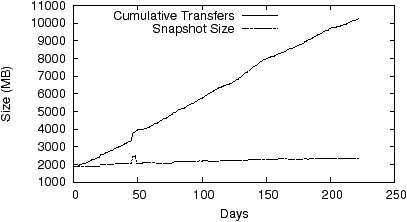 |
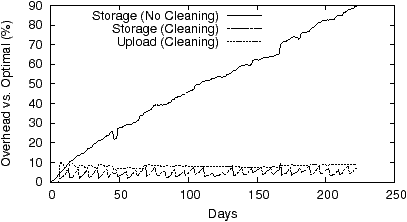 |
| (a) | (b) |
| Figure 2: (a) Storage and network overhead for an optimal backup of the
files from the user trace.
(b) Overheads with and without cleaning; segments are cleaned at 60%
utilization. Only storage overheads are shown for the no-cleaning case
since there is no network transfer overhead without cleaning. |
The simulator tracks three overheads associated with performing
backups. It tracks storage overhead, or the total number of bytes to
store a set of snapshots computed as the sum of the size of each
segment needed. Storage overhead includes both actual file data as
well as wasted space within segments. It tracks network overhead, the
total data that must be transferred over the network to accomplish a
backup. On graphs, we show this overhead as a cumulative value: the
total data transferred from the beginning of the simulation until the
given day. Since remote backup services have per-file charges, the
simulator also tracks segment overhead as the number of segments
created during the process of making backups.
The simulator also models two snapshot scenarios. In the single
snapshot scenario, the simulator maintains only one snapshot
remotely and it deletes all previous snapshots. In the multiple
snapshot scenario, the simulator retains snapshots according to a
pre-determined backup schedule. In our experiments, we keep the most
recent seven daily snapshots, with additional weekly snapshots
retained going back farther in time so that a total of 12 snapshots
are kept. This schedule emulates the backup policy an enterprise
might employ.
The simulator makes some simplifying assumptions that we explore later
when evaluating our implementation. The simulator detects changes to
files in the traces using a per-file hash. Thus, the simulator cannot
detect changes to only a portion of a file, and assumes that the
entire file is changed. The simulator also does not model compression
or metadata. We account for sub-file changes, compression, and
metadata overhead when evaluating the prototype in
Section 5.4.
5.2.2 Optimal Baseline
A simple storage interface for remote backup can incur an overhead
penalty relative to more sophisticated approaches. To quantify the
overhead of this approach, we use an idealized optimal backup as
a basis of comparison.
For our simulations, the optimal backup is one in which no more data
is stored or transferred over the network than is needed. Since
simulation is done at a file granularity, the optimal backup will
transfer the entire contents of a file if any part changes. Optimal
backup will, however, perform data de-duplication at a file level,
storing only one copy if multiple files have the same hash value. In
the optimal backup, no space is lost to fragmentation when deleting
old snapshots. Cumulus could achieve this optimal performance in this
simulation by storing each file in a separate segment—that is, to
never bundle files together into larger segments. As discussed in
Section 3.2 and as our simulation results show,
though, there are good reasons to use segments with sizes larger
than the average file.
As an example of these costs and how we measure them,
Figure 2(a) shows the optimal storage and upload
overheads for daily backups of the 223 days of the user trace. In
this simulation, only a single snapshot is retained each day. Storage
grows slowly in proportion to the amount of data in a snapshot, and
the cumulative network transfer grows linearly over time.
Figure 2(b) shows the results of two simulations of
Cumulus backing up the same data. The graph shows the overheads relative
to optimal backup; a backup as good as optimal would have 0% relative
overhead. These results clearly demonstrate the need for cleaning
when using a simple storage interface for backup. When segments are
not cleaned (only deleting segments that by chance happen to be
entirely no longer needed), wasted storage space grows quickly with
time—by the end of the simulation at day 223, the size of a
snapshot is nearly double the required size. In contrast, when
segments are marked for cleaning at the 60% utilization threshold,
storage overhead quickly stabilizes below 10%. The overhead in extra
network transfers is similarly modest.
5.2.3 Cleaning Policies
 |
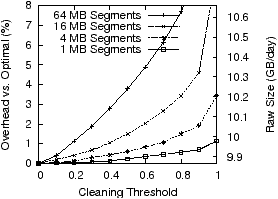 |
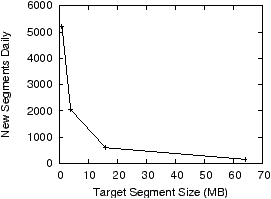 |
| (a) Average daily storage |
(b) Average daily upload |
(c) Average segments per day |
| Figure 3: Overheads for backups in the fileserver trace. |
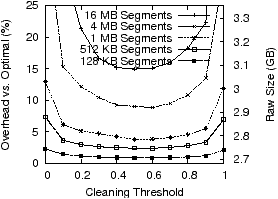 |
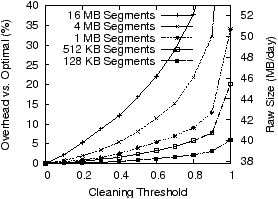 |
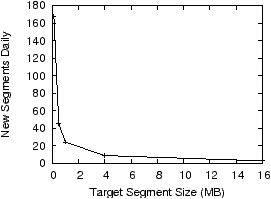 |
| (a) Average daily storage |
(b) Average daily upload |
(c) Average segments per day |
| Figure 4: Overheads for backups in the user trace. |
Cleaning is clearly necessary for efficient backup, but it is also
parameterized by two metrics: the size of the segments used for
aggregation, transfer, and storage
(Section 3.2), and the threshold at which
segments will be cleaned (Section 3.5). In our next set
of experiments, we explore the parameter space to quantify the impact
of these two metrics on backup performance.
Figures 3 and 4 show the
simulated overheads of backup with Cumulus using the fileserver and user
traces, respectively. The figures show both relative overheads to
optimal backup (left y-axis) as well as the absolute overheads
(right y-axis). We use the backup policy of multiple daily and
weekly snapshots as described in Section 5.2.1. The
figures show cleaning overhead for a range of cleaning thresholds and
segment sizes. Each figure has three graphs corresponding to the
three overheads of remote backup to an online service. Average
daily storage shows the average storage requirements per day over the
duration of the simulation; this value is the total storage needed for
tracking multiple backup snapshots, not just the size of a single
snapshot. Similarly, average daily upload is
the average of the data transferred each day of the simulation,
excluding the first; we exclude the first day since any backup
approach must transfer the entire initial filesystem. Finally, average segments per day tracks the number of new segments uploaded
each day to account for per-file upload and storage costs.
Storage and upload overheads improve with decreasing segment size, but
at small segment sizes (< 1 MB) backups require very large numbers of
segments and limit the benefits of aggregating file data
(Section 3.2). As expected, increasing the
cleaning threshold increases the network upload overhead. Storage
overhead with multiple snapshots, however, has an optimum cleaning
threshold value. Increasing the threshold initially decreases storage
overhead, but high thresholds increase it again; we explore this
behavior further below.
Both the fileserver and user workloads exhibit similar sensitivities to
cleaning thresholds and segment sizes. The user workload has higher
overheads relative to optimal due to smaller average files and more
churn in the file data, but overall the overhead penalties remain low.
Figures 3(a) and 4(a) show
that there is a cleaning threshold that minimizes storage overheads.
Increasing the cleaning threshold intuitively reduces storage overhead
relative to optimal since the more aggressive cleaning at higher
thresholds will delete wasted space in segments and thereby reduce
storage requirements.
Figure 5 explains
why storage overhead increases again at higher cleaning thresholds.
It shows three curves, the 16 MB segment size curve from
Figure 3(a) and two curves that decompose the
storage overhead into individual components
(Section 3.5). One is overhead due to duplicate copies
of data stored over time in the cleaning process; cleaning at lower
thresholds reduces this component. The other is due to wasted space in
segments which have not been cleaned; cleaning at higher thresholds
reduces this component. A cleaning threshold near the middle, however,
minimizes the sum of both of these overheads.
| Figure 5: Detailed breakdown of storage overhead when using a 16 MB
segment size for the fileserver workload. |
5.3 Paying for Remote Backup
The evaluation in the previous section measured the overhead of Cumulus in
terms of storage, network, and segment resource usage. Remote backup as
a service, however, comes at a price. In this section, we calculate
monetary costs for our two workload models, evaluate cleaning threshold
and segment size in terms of costs instead of resource usage, and
explore how cleaning should adapt to minimize costs as the ratio of
network and storage prices varies. While similar, there are differences
between this problem and the typical evaluation of cleaning policies for
a typical log-structured file system: instead of a fixed disk size and
a goal to minimize I/O, we have no fixed limits but want to minimize
monetary cost.
We use the prices for Amazon S3 as an initial point in the pricing
space. As of January 2009, these prices are (in US dollars):
| Storage: | $0.15 per GB · month |
| Upload: | $0.10 per GB |
| Segment: | $0.01 per 1000 files uploaded |
With this pricing model, the segment cost for uploading an empty
file is equivalent to the upload cost for uploading
approximately 100 KB of data, i.e., when uploading 100 KB files, half
of the cost is for the bandwidth and half for the upload request
itself. As the file size increases, the per-request component becomes
an increasingly smaller part of the total cost.
| Fileserver | Amount | Cost |
| Initial upload | 3563 GB | $356.30 |
| Upload | 303 GB/month | $30.30/month |
| Storage | 3858 GB | $578.70/month |
| User | Amount | Cost |
| Initial upload | 1.82 GB | $0.27 |
| Upload | 1.11 GB/month | $0.11/month |
| Storage | 2.68 GB | $0.40/month |
| Table 3: Costs for backups in US dollars, if performed optimally, for
the fileserver and user traces using current prices for Amazon S3. |
Neglecting for the moment the segment upload costs,
Table 3 shows the monthly storage and
upload costs for each of the two traces. Storage costs dominate
ongoing costs. They account for about 95% and 78% of the monthly
costs for the fileserver and user traces, respectively. Thus, changes
to the storage efficiency will have a more substantial effect on total
cost than changes in bandwidth efficiency. We also note that the
absolute costs for the home backup scenario are very low, indicating
that Amazon’s pricing model is potentially quite reasonable for
consumers: even for home users with an order of magnitude more data to
backup than our user workload, yearly ongoing costs are roughly US$50.
| Figure 6: Costs in US dollars for backups in the fileserver assuming
Amazon S3 prices. Costs for the user trace differ in absolute
values but are qualitatively similar. |
Whereas Figure 3 explored the parameter space
of cleaning thresholds and segment sizes in terms of resource
overhead, Figure 6 shows results in terms of
overall cost for backing up the fileserver trace. These results show
that using a simple storage interface for remote backup also incurs
very low additional monetary cost than optimal backup, from 0.5–2%
for the fileserver trace depending on the parameters, and as low as
about 5% in the user trace.
When evaluated in terms of monetary
costs, though, the choices of cleaning parameters change compared to the
parameters in terms of resource usage. The cleaning threshold
providing the minimum cost is smaller and less aggressive (threshold
= 0.4) than in terms of resource usage (threshold = 0.6).
However, since overhead is not overly sensitive to the cleaning
threshold, Cumulus still provides good performance even if the cleaning
threshold is not tuned optimally. Furthermore, in contrast to resource
usage, decreasing segment size does not always decrease overall cost.
At some point—in this case between 1–4 MB—decreasing segment size
increases overall cost due to the per-file pricing. We do not evaluate
segment sizes less than 1 MB for the fileserver trace since, by 1 MB,
smaller segments are already a loss. The results for the user workload,
although not shown, are qualitatively similar, with a segment size of
0.5 MB to 1 MB best.
The pricing model of Amazon S3 is only one point in the pricing space.
As a final cost experiment, we explore how cleaning should adapt to
changes in the relative price of storage versus network.
Figure 7 shows the optimal cleaning
threshold for the fileserver and user workloads as a function of the
ratio of storage to network cost. The storage to network ratio
measures the relative cost of storing a gigabyte of data for a month
and uploading a gigabyte of data. Amazon S3 has a ratio of 1.5. In
general, as the cost of storage increases, it becomes advantageous to
clean more aggressively (the optimal cleaning threshold increases).
The ideal threshold stabilizes around 0.5–0.6 when storage is at
least ten times more expensive than network upload, since cleaning too
aggressively will tend to increase storage costs.
| Figure 7: How the optimal threshold for cleaning changes as the relative
cost of storage vs. network varies. |
5.4 Prototype Evaluation
In our final set of experiments, we compare the overhead of the Cumulus prototype implementation with other backup systems. We also evaluate
the sensitivity of compression on segment size, the overhead of metadata
in the implementation, the performance of sub-file incrementals and
restores, and the time it takes to upload data to a remote service like
Amazon S3.
5.4.1 System Comparisons
| System | Storage | Upload | Operations |
| Jungle Disk | ≈ 2 GB | 1.26 GB | 30000 |
| | $0.30 | $0.126 | $0.30 |
| Brackup | 1.340 GB | 0.760 GB | 9027 |
| (default) | $0.201 | $0.076 | $0.090 |
| Brackup | 1.353 GB | 0.713 GB | 1403 |
| (aggregated) | $0.203 | $0.071 | $0.014 |
| Cumulus | 1.264 GB | 0.465 GB | 419 |
| | $0.190 | $0.047 | $0.004 |
| Table 4: Cost comparison for backups based on replaying actual file
changes in the user trace over a three month period. Costs for Cumulus
are lower than those shown in Table 3 since
that evaluation ignored the possible benefits of compression and
sub-file incrementals, which are captured here. Values are listed on a
per-month basis. |
First, we provide some results from running our Cumulus prototype and
compare with two existing backup tools that also target Amazon S3:
Jungle Disk and Brackup. We use the complete file contents included in
the user trace to accurately measure the behavior of our full Cumulus
prototype and other real backup systems. For each day in the first
three months of the user trace, we extract a full snapshot of all files,
then back up these files with each of the backup tools. We compute
the average cost, per month, broken down into storage, upload bandwidth,
and operation count (files created or modified).
We configured Cumulus to clean segments with less then 60%
utilization on a weekly basis. We evaluate Brackup with two different
settings. The first uses the merge_files_under=1kB option to
only aggregate files if those files are under 1 KB in size (this
setting is recommended). Since this setting still results in many
small files (many of the small files are still larger than 1 KB), a
“high aggregation” run sets merge_files_under=16kB to capture
most of the small files and further
reduce the operation count. Brackup includes the digest database in the
files backed up, which serves a role similar to the database Cumulus
stores locally. For fairness in the comparison, we subtract the size
of the digest database from the sizes reported for Brackup.
Both Brackup and Cumulus use gpg to encrypt data in the test;
gpg compresses the data with gzip prior to encryption.
Encryption is enabled in Jungle Disk, but no compression is available.
In principle, we would expect backups with Jungle Disk to be near
optimal in terms of storage and upload since no space is wasted due to
aggregation. But, as a tradeoff, Jungle Disk will have a much higher
operation count. In practice, Jungle Disk will also suffer from a lack
of de-duplication, sub-file incrementals, and compression.
Table 4 compares the estimated backup costs for
Cumulus with Jungle Disk and Brackup. Several key points stand out in
the comparison:
-
Storage and upload requirements for Jungle Disk are larger, owing
primarily to the lack of compression.
- Except in the high aggregation case, both Brackup and Jungle Disk
incur a large cost due to the many small files stored to S3. The
per-file cost for uploads is larger than the per-byte cost, and for
Jungle Disk significantly so.
- Brackup stores a complete copy of all file metadata with each
snapshot, which in total accounts for 150–200 MB/month of the upload
cost. The cost in Cumulus is lower since Cumulus can re-use metadata.
Comparing storage requirements of Cumulus with the average size of a
full backup with the venerable tar utility, both are within 1%:
storage overhead in Cumulus is roughly balanced out by gains achieved
from de-duplication. Using duplicity as a proxy for near-optimal
incremental backups, in a test with two months from the user trace
Cumulus uploads only about 8% more data than is needed. Without
sub-file incrementals in Cumulus, the figure is closer to 33%.
The Cumulus prototype thus shows that a service with a simple storage
interface can achieve low overhead, and that Cumulus can achieve a lower
total cost than other existing backup tools targeting S3.
While perhaps none of the systems are yet optimized for speed, initial
full backups in Brackup and Jungle Disk were both notably slow. In the
tests, the initial Jungle Disk backup took over six hours, Brackup
(to local disk, not S3) took slightly over two hours, and Cumulus (to
S3) approximately 15 minutes. For comparison, simply archiving all
files with tar to local disk took approximately 10 minutes.
For incremental backups, elapsed times for the tools were much more
comparable. Jungle Disk averaged 248 seconds per run archiving to S3.
Brackup averaged 115 seconds per run and Cumulus 167 seconds, but in
these tests each were storing snapshots to local disk rather than to
Amazon S3.
5.4.2 Segment Compression
Next we isolate the effectiveness of compression at reducing the size of
the data to back up, particularly as a function of segment size and
related settings. We used as a sample the full data contained in the
first day of the user trace: the uncompressed size is 1916 MB, the
compressed tar size is 1152 MB (factor of 1.66), and files
individually compressed total 1219 MB (1.57×), 5.8% larger
than whole-snapshot compression.
When aggregating data together into segments, we found that larger input
segment sizes yielded better compression, up to about 300 KB when using
gzip and 1–2 MB for bzip2 where compression ratios
leveled off.
The Cumulus prototype stores metadata for each file in a backup snapshot
in a text format, but after compression the format is still quite
efficient. In the full tests on the user trace, the metadata for a
full backup takes roughly 46 bytes per item backed up. Since most
items include a 20-byte hash value which is unlikely to be
compressible, the non-checksum components of the metadata average
under 30 bytes per file.
Metadata logs can be stored incrementally: new snapshots can reference
the portions of old metadata logs that are not modified. In the full
user trace replay, a full metadata log was written to a snapshot
weekly. On days where only differences were written out, though, the
average metadata log delta was under 2% of the size of a full
metadata log. Overall, across all the snapshots taken, the
data written out for file metadata was approximately 5%
of the total size of the file data itself.
5.4.4 Sub-File Incrementals
To evaluate the support for sub-file incrementals in Cumulus, we make
use of files extracted from the user trace that are frequently
modified in place. We extract files from a 30-day period at the start
of the trace. File A is a frequently-updated Bayesian spam filtering
database, about 90% of which changes daily. File B records the state
for a file-synchronization tool (unison), of which an average of 5%
changes each day—however, unchanged content may still shift to
different byte offsets within the file. While these samples do not
capture all behavior, they do represent two distinct and notable classes of
sub-file updates.
| | File A | File B |
| File size | 4.860 MB | 5.890 MB |
| Compressed size | 1.547 MB | 2.396 MB |
| Cumulus size | 5.190 MB | 3.081 MB |
| Size overhead | 235% | 29% |
| rdiff delta | 1.421 MB | 122 KB |
| Cumulus delta | 1.527 MB | 181 KB |
| Delta overhead | 7% | 48% |
| Table 5: Comparison of Cumulus sub-file incrementals with an idealized
system based on rdiff, evaluated on two sample files from the user
trace. |
To provide a point of comparison, we use rdiff [14] to
generate an rsync-style delta between consecutive file versions.
Table 5 summarizes the results.
The size overhead measures the storage cost of sub-file
incrementals in Cumulus. To reconstruct the latest version of a file,
Cumulus might need to read data from many past versions, though cleaning
will try to keep this bounded. This overhead compares the average size
of a daily snapshot (“Cumulus size”) against the average compressed
size of the file backed up. As file churn increases overhead tends to
increase.
The delta overhead compares the data that must be uploaded daily
by Cumulus (“Cumulus delta”) against the average size of patches
generated by rdiff (“rdiff delta”). When only a small portion of the
file changes each day (File B), rdiff is more efficient than Cumulus in
representing the changes. However, sub-file incrementals are still a
large win for Cumulus, as the size of the incrementals is still much
smaller than a full copy of the file. When large parts of the file
change daily (File A), the efficiency of Cumulus approaches that of
rdiff.
5.4.5 Upload Time
As a final experiment, we consider the time to upload to a remote
storage service. Our Cumulus prototype is capable of uploading snapshot
data directly to Amazon S3. To simplify matters, we evaluate upload
time in isolation, rather than as part of a full backup, to provide a
more controlled environment. Cumulus uses the boto [4] Python
library to interface with S3.
As our measurements are from one experiment from a single computer (on a
university campus network), they should not be taken as a good measure
of the overall performance of S3. For large files—a megabyte or
larger—uploads proceed at a maximum rate of about 800 KB/s. According
to our results there is an overhead equivalent to a latency of roughly
100 ms per upload, and for small files this dominates the actual time
for data transfer. It is thus advantageous to upload data in larger
segments, as Cumulus does. More recent tests indicate that speeds may have
improved.
The S3 protocol, based on HTTP, does not support pipelining multiple
upload requests. Multiple uploads in parallel could reduce overhead
somewhat. Still, it remains beneficial to perform uploads in larger
units.
For perspective, assuming the maximum transfer rates above, ongoing
backups for the fileserver and user workloads will take on average
3.75 hours and under a minute, respectively. Overheads from cleaning
will increase these times, but since network overheads from cleaning
are generally small, these upload times will not change by much. For
these two workloads, backup times are very reasonable for daily
snapshots.
5.4.6 Restore Time
To completely restore all data from one of the user snapshots takes
approximately 11 minutes, comparable to but slighly faster than the time
required for an initial full backup.
When restoring individual files from the user dataset, almost all time
is spent extracting and parsing metadata—there is a fixed cost of
approximately 24 seconds to parse the metadata to locate requested
files. Extracting requested files is relatively quick, under a second
for small files.
Both restore tests were done from local disk; restoring from S3 will be
slower by the time needed to download the data.
6 Conclusions
It is fairly clear that the market for Internet-hosted backup service
is growing. However, it remains unclear what form of this service
will dominate. On one hand, it is in the natural interest of service
providers to package backup as an integrated service since that will
both create a “stickier” relationship with the customer and allow
higher fees to be charged as a result. On the other hand, given our
results, the customer’s interest may be maximized via an open market
for commodity storage services (such as S3), increasing competition due
to the low barrier to switching providers, and thus driving down
prices. Indeed, even today integrated backup providers charge between
$5 and $10 per month per user while the S3 charges for backing up
our test user using the Cumulus system was only $0.24 per
month. (For example, Symantec’s Protection Network charges
$9.99 per month for 10GB of storage and EMC’s MozyPro service costs
$3.95 + $0.50/GB per month per desktop.)
Moreover, a thin-cloud approach to backup allows one to easily hedge
against provider failures by backing up to multiple providers. This
strategy may be particularly critical for guarding against business risk—a
lesson that has been learned the hard way by customers whose hosting
companies have gone out of business. Providing the same hedge using
the integrated approach would require running multiple backup systems
in parallel on each desktop or server, incurring redundant overheads
(e.g., scanning, compression, etc.) that will only increase as disk
capacities grow.
Finally, while this paper has focused on an admittedly simple
application, we believe it identifies a key research agenda influencing
the future of “cloud computing”: can one build a competitive product
economy around a cloud of abstract commodity resources, or do underlying
technical reasons ultimately favor an integrated service-oriented
infrastructure?
7 Acknowledgments
The authors would like to thank Chris X. Edwards and Brian Kantor for
assistance in collecting fileserver traces and other computing support.
We would also like to thank our shepherd Niraj Tolia and the anonymous
reviewers for their time and insightful comments regarding Cumulus and
this paper. This work was supported in part by the National Science
Foundation grant CNS-0433668 and the UCSD Center for Networked Systems.
Vrable was further supported in part by a National Science Foundation
Graduate Research Fellowship.
References
-
[1]
-
Agrawal, N., Bolosky, W. J., Douceur, J. R., and Lorch, J. R.
A five-year study of file-system metadata.
ACM Trans. Storage 3, 3 (2007), 9.
- [2]
-
The Advanced Maryland Automatic Network Disk Archiver.
https://www.amanda.org/.
- [3]
-
Amazon Web Services.
Amazon Simple Storage Service.
https://aws.amazon.com/s3/.
- [4]
-
boto: Python interface to Amazon Web Services.
https://code.google.com/p/boto/.
- [5]
-
Cox, L. P., Murray, C. D., and Noble, B. D.
Pastiche: Making backup cheap and easy.
In Proceedings of the 5th Symposium on Operating Systems Design
and Implementation (OSDI) (2002), USENIX, pp. 285–298.
- [6]
-
Douceur, J. R., Adya, A., Bolosky, W. J., Simon, D., and Theimer, M.
Reclaiming space from duplicate files in a serverless distributed
file system.
Technical Report MSR-TR-2002-30.
- [7]
-
Escoto, B.
rdiff-backup.
https://www.nongnu.org/rdiff-backup/.
- [8]
-
Escoto, B., and Loafman, K.
Duplicity.
https://duplicity.nongnu.org/.
- [9]
-
Fitzpatrick, B.
Brackup.
https://code.google.com/p/brackup/,
https://brad.livejournal.com/tag/brackup.
- [10]
-
FUSE: Filesystem in userspace.
https://fuse.sourceforge.net/.
- [11]
-
Henson, V.
An analysis of compare-by-hash.
Proceedings of HotOS IX: The 9th Workshop on Hot Topics in
Operating Systems (2003).
- [12]
-
Henson, V.
The code monkey’s guide to cryptographic hashes for content-based
addressing, Nov. 2007.
https://www.linuxworld.com/news/2007/111207-hash.html.
- [13]
-
Jungle disk.
https://www.jungledisk.com/.
- [14]
-
librsync.
https://librsync.sourcefrog.net/.
- [15]
-
Muthitacharoen, A., Chen, B., and Mazières, D.
A low-bandwidth network file system.
In Proceedings of the 18th ACM Symposium on Operating Systems
Principles (SOSP) (2001), ACM, pp. 174–187.
- [16]
-
Preston, W. C.
Backup & Recovery.
O’Reilly, 2006.
- [17]
-
Quinlan, S., and Dorward, S.
Venti: a new approach to archival storage.
In Proceedings of the 1st USENIX Conference on File and Storage
Technologies (FAST) (2002), USENIX Association.
- [18]
-
Rosenblum, M., and Ousterhout, J. K.
The design and implementation of a log-structured file system.
ACM Trans. Comput. Syst. 10, 1 (1992), 26–52.
- [19]
-
rsnapshot.
https://www.rsnapshot.org/.
- [20]
-
Sqlite.
https://www.sqlite.org/.
- [21]
-
Summers, B., and Wilson, C.
Box backup.
https://www.boxbackup.org/.
- [22]
-
Tridgell, A.
Efficient Algorithms for Sorting and Synchronization.
PhD thesis, Australian National University, Feb. 1999.
- [23]
-
Wang, J., and Hu, Y.
WOLF–A novel reordering write buffer to boost the performance of
log-structured file systems.
In Proceedings of the 1st USENIX Conference on File and Storage
Technologies (FAST) (2002), USENIX Association.
- [24]
-
Weatherspoon, H., Eaton, P., Chun, B.-G., and Kubiatowicz, J.
Antiquity: Exploiting a secure log for wide-area distributed storage.
In EuroSys ’07: Proceedings of the 2nd ACM SIGOPS/EuroSys
European Conference on Computer Systems 2007 (New York, NY, USA, 2007),
ACM, pp. 371–384.
- [25]
-
Wheeler, D. A.
SLOCCount.
https://www.dwheeler.com/sloccount/.
- [26]
-
Zhu, B., Li, K., and Patterson, H.
Avoiding the disk bottleneck in the data domain deduplication file
system.
In Proceedings of the 6th USENIX Conference on File and
Storage Technologies (FAST) (2008), USENIX Association, pp. 269–282.
